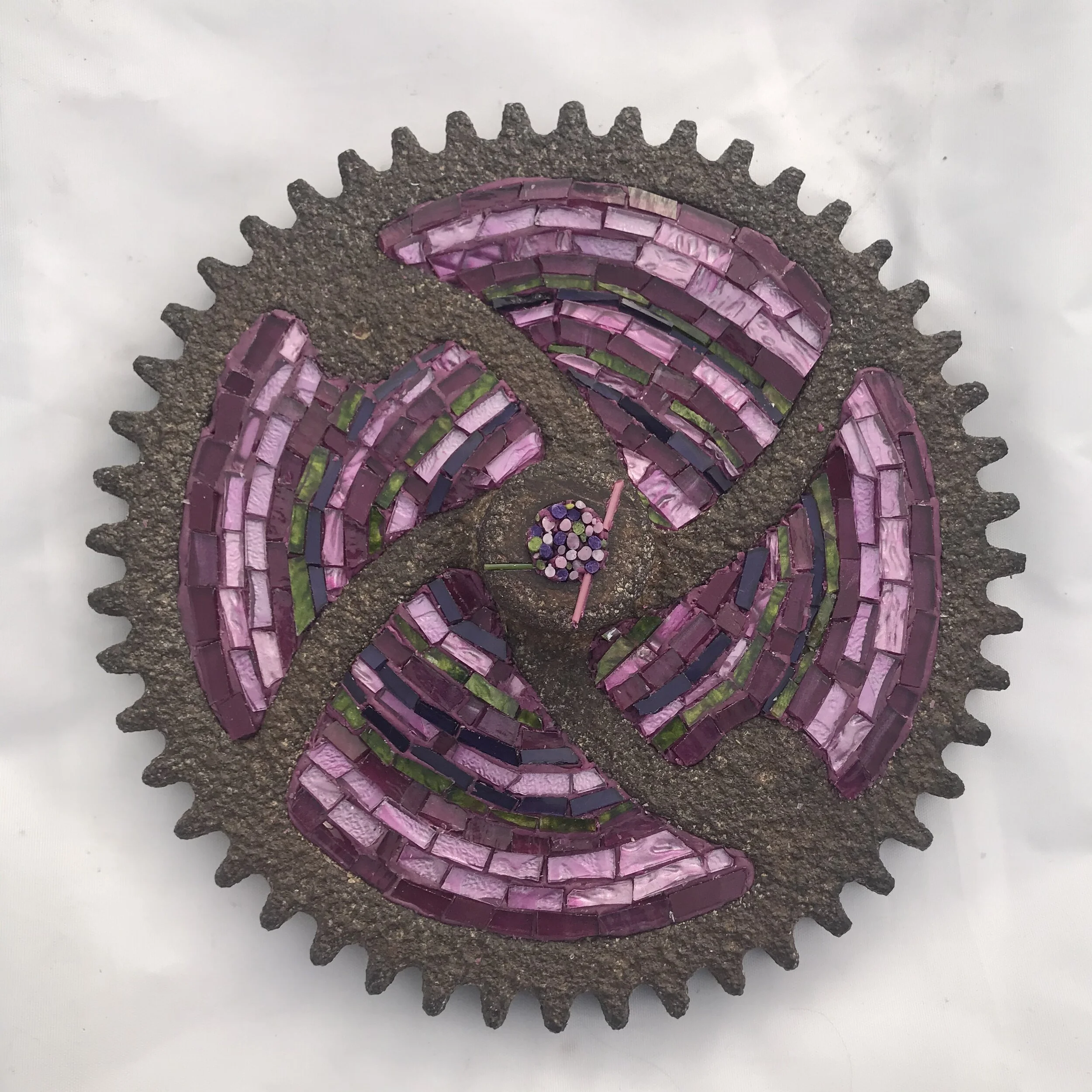

Tiny rings: I first volunteered to make three rings and Rachel said please do six, so I did and mailed them back to her. Then I said I’d do 10 more, but ended up doing a total of 63! These are 2-inch ceramic rings that are a color study of 600 rings done by mosaic artists from all over the world.

Gears: The New England Mosaic Society did a Gears project for the Ruins Project. I filled 5 small gears with malmischiato and brass, copper and aluminum wire.
This is an antique 8-inch gear that was probably part of an industrial textile loom powered by coal in the 19th century in New England. My grandmother’s father (East Germany 1882) and her husband’s grandfather (Manchester, England 1960) got their start in the US as weavers in the textile mills of Fall River, MA, 1860-1935. My grandmother also was a master weaver in the 1920s-30s in the same mills. My mother became an accomplished handweaver in the 1980s-1990s. I also did a fair amount of handweaving, but gave it up for the endless creative opportunities in mosaic. I am creating this mosaic as an homage to my foremothers and fathers, using painted stained glass and a bit of malmischiato in the center) Copy and paste the link below to watch a video created by the Charles River Museum of Technology and Innovation featuring this and other works.
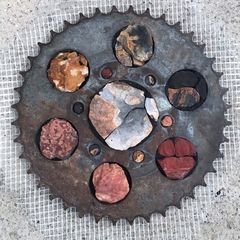
The study in red dog gear before its three years on the gear wall of The Ruins Project.
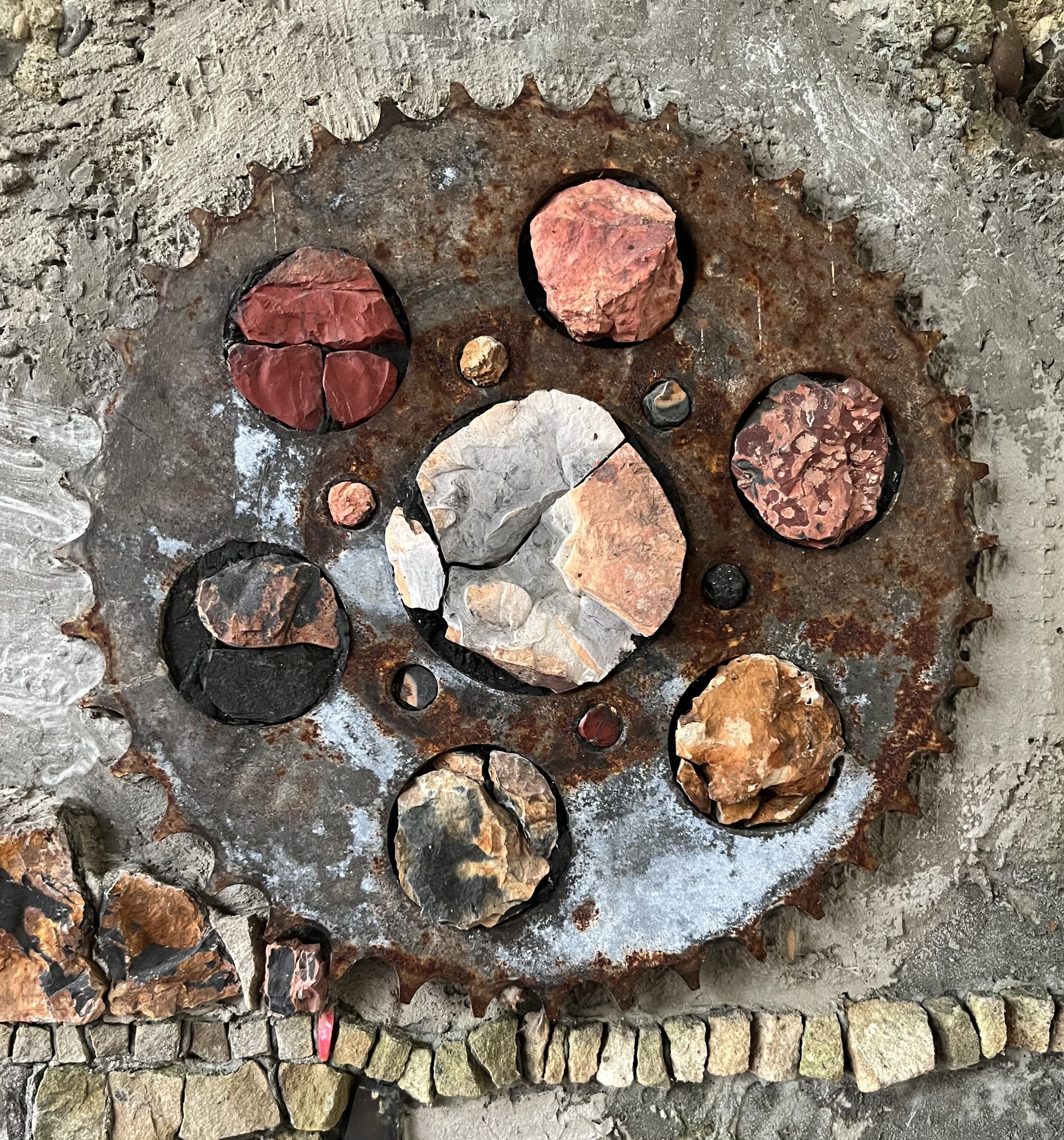
When I visited in Ruins in 2021 Rachel gave us permission to dig up a bit of red dog. I filled this gear with choice bits of it and when we visited in 2024 I took this photo of it in situ.

My Scrap House quilt square for the #thepatchhouseproject at #theruinsproject. After cutting up pounds of plates in all hues, I ended up with color scheme of my own house’s interior 🙄. The women and the cat are from five Rorstrand porcelain plates from Sweden, and most of the rest is made from vintage Japanese plates. Sort of a temple of domesticity. #theruinsproject #thepatchhouseproject @laticrete

One of three quilt squares I made for the Patch House Quilt for the Ruins Project. This one is called Homespun. It was good challenge for me cutting the white marble and the little black squares in the basket weave. @theruinsproject #ruins project @laticrete @patchhouseproject

This is one of three stone houses I made for The Ruins Patch House Project. The blue sections are lapis lazuli, the white is marble, and the brown is from the unfinished side of travertine tiles left over from someone's bathroom project.

One of three quilt squares I made for the Patch House Quilt for the Ruins Project. This one is called Red House, and its door is made of blue 24c gold smalti. It has a line of New England stone I foraged from Mashnee beach.

The stone house quilt at The Ruins Project.

Two hexagon triptychs I made for The Ruins Project Bee Hive Project color study. They are both all smalti, and the orange one has three Lisa Bonin cabochons in the middle of each hexagon.

My study in orange gradations in situ at The Ruins Beehive Project.

Lady Red Tail on mesh before installation at The Ruins Project. It was made predominantly with stone foraged at the Ruins itself, of red dog and Marcellus shale. The white is marble. I struggled with this one, my first real representational piece. The stone was hard to work with, as it crumbled and flaked expectantly.
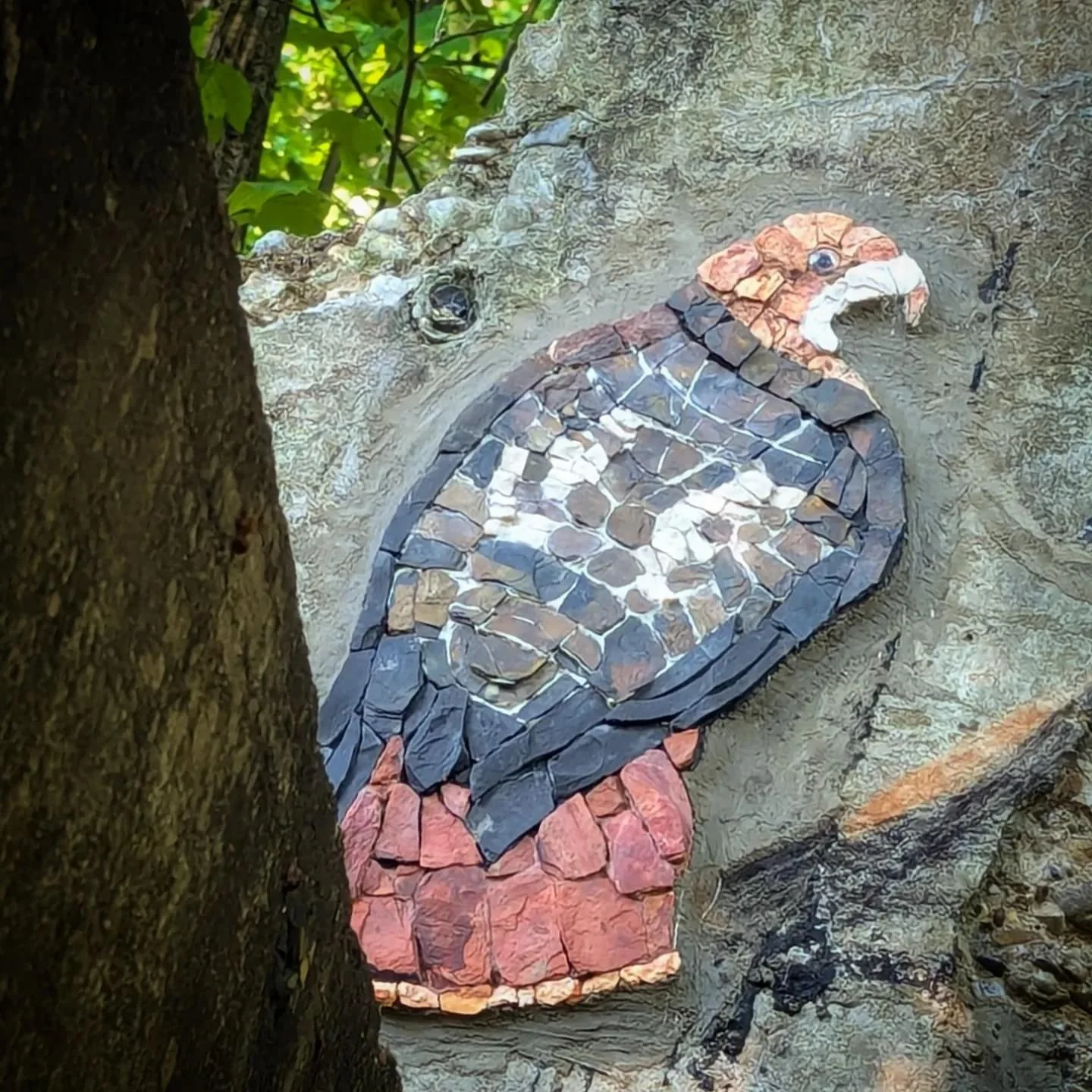
Lady Redtail close up after installation.
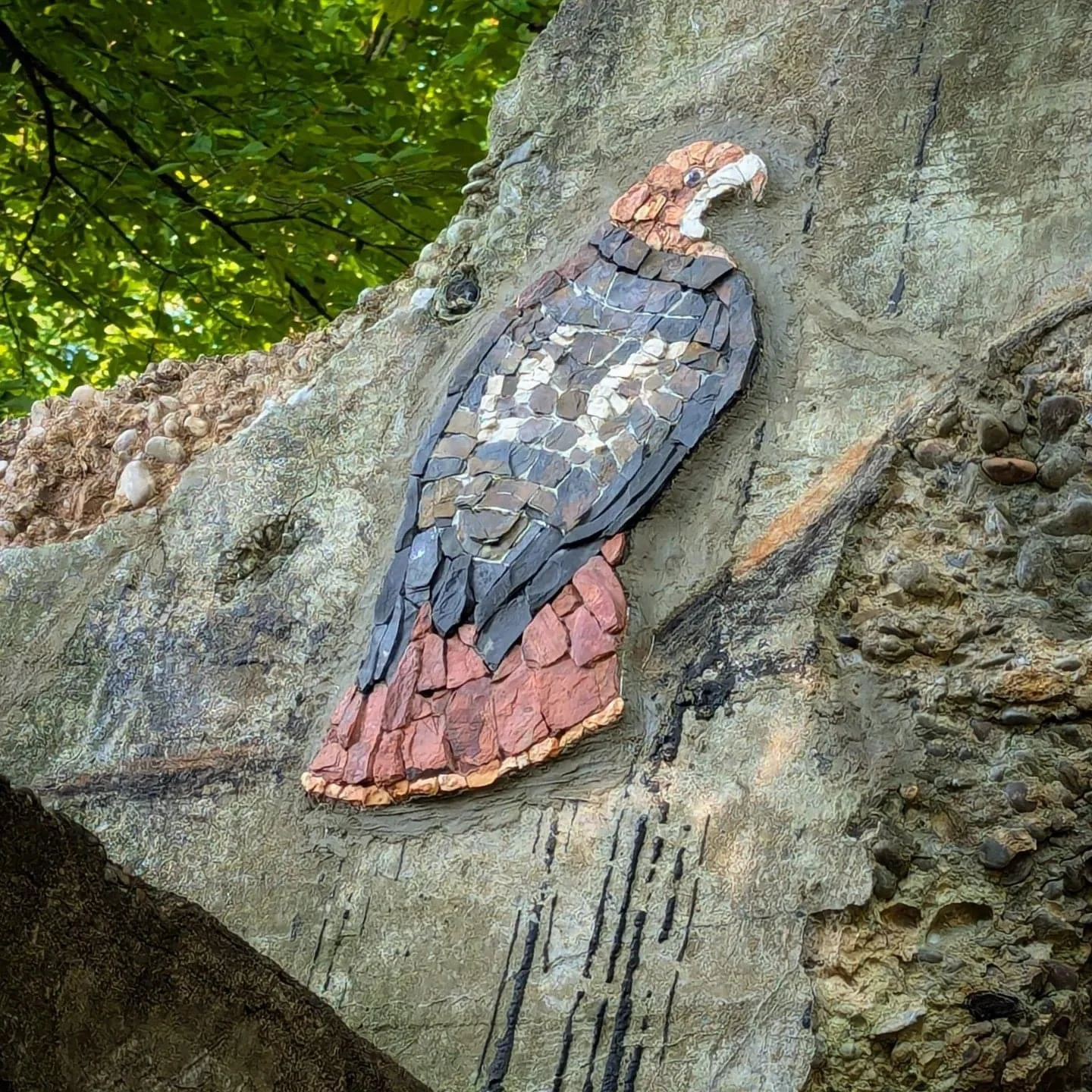
Lady Redtail on the wall of the Ruins. She eventually have a tree painted under her to perch on.
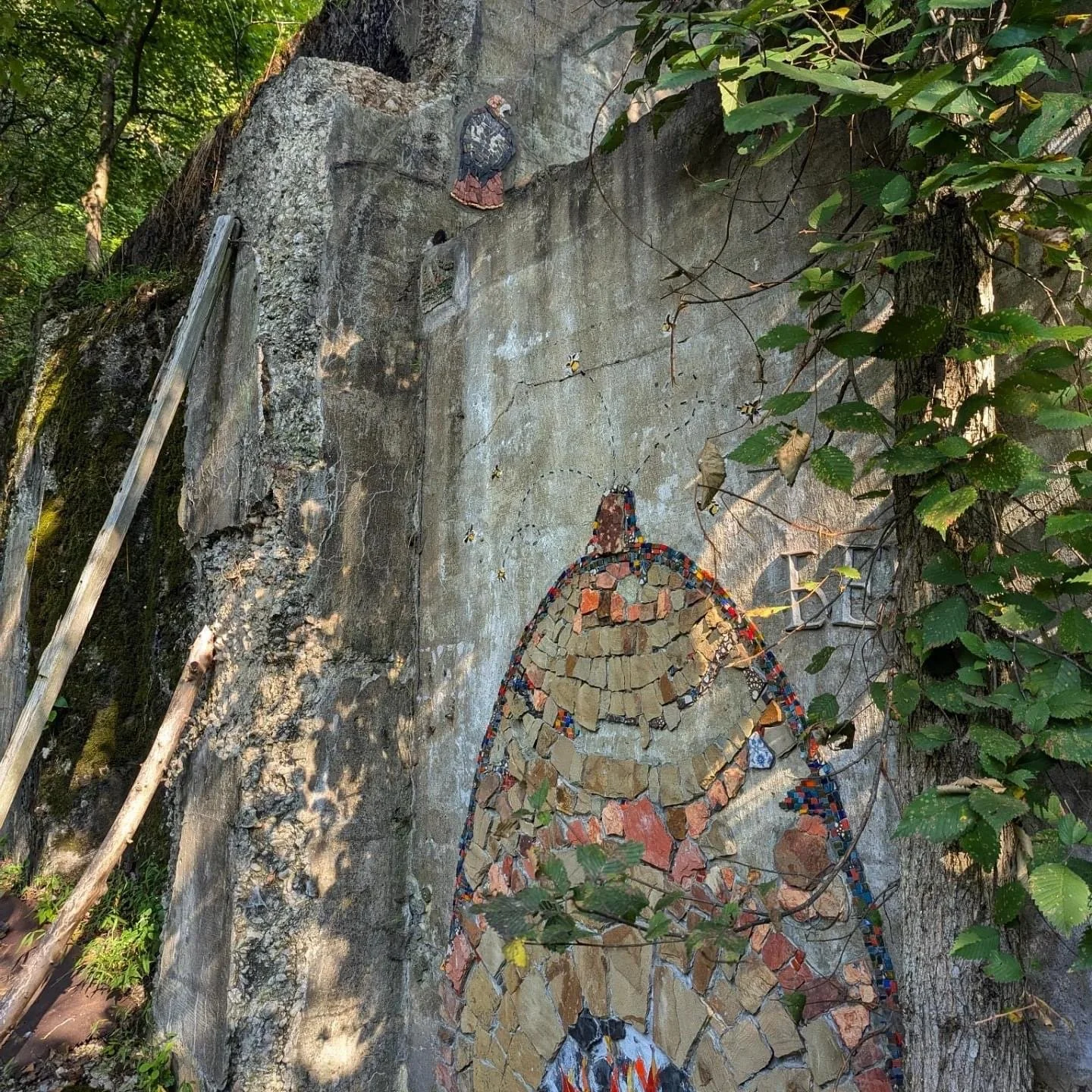
Lady Redtail from a distance from outside the Ruins wall. The foreground image is the Beehive- representing the coke ovens that cooked the coal into coke to be made into steel.
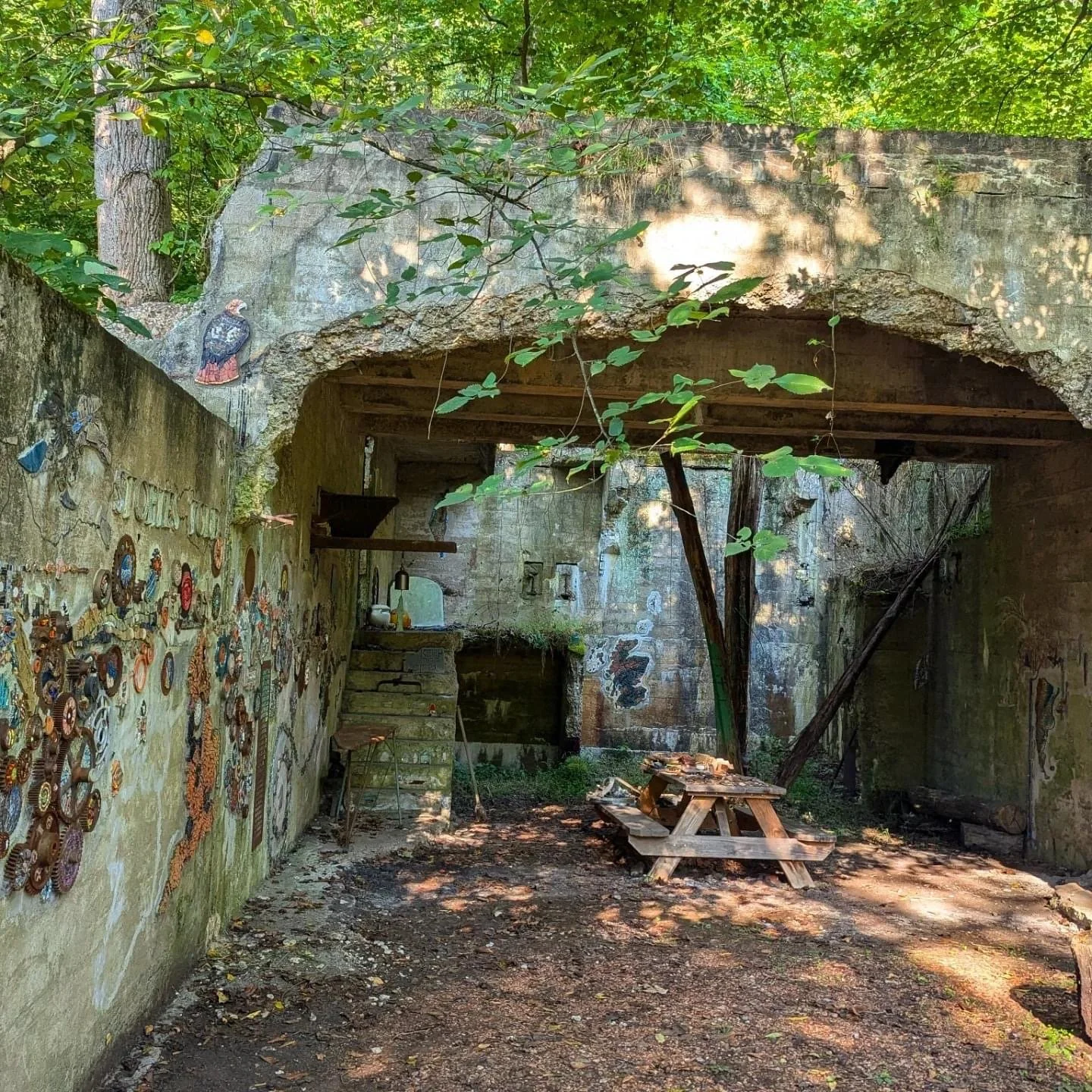
Lady Redtail, upper left, in the Ruins Project. August 2024. Behind the picnic table is where George and I foraged the red dog that I used for her head and tail. The brownish and the black shale were foraged elsewhere near the Ruins.

My brief foray into malmischiato jewelry.
My contributions to The Ruins Project
Rachel has created The Ruins Project (ruinsproject.com, sagermosaics.com) that has become a mosaic museum in an abandoned coal mine on her property, next to a rail trail and the Youghiogheny River in Pennsylvania. Rachel works with mosaic and other artists all over the world to tell the story of coal and its coal miners.
I learned to hand pulled glass threads called filati to make malmischiato (“badly mixed” in Italian) from Rachel Sager in her on-line videos. I quickly got addicted to the mesmerizing mixing of colors, melting bits with a blowtorch and cutting those threads in little pieces to mosaic with.
Rachel has been a huge inspiration for me in my approach to artmaking.
Her reverence and honoring the history of our families and communities resonates with me and has given me a framework for integrating my genealogical research with my mosaic art.
The four rules of the Ruins give guidance to the art produced for the ruins.
Rule #1 Honor what was.
In some ways, this simply means not dishonoring the memories of the thousands of miners who worked at Banning #2 Mine and their many descendants who still live nearby. We come from coal here and coal brings out a passion in people. That can be good and bad. Coal was not turned into steel and steel into buildings in a bubble. There are mothers and fathers and children everywhere whose lives were built on this four letter word.
Rule #2 Build Relationships with Raw Material
These walls are not interested in a piece of art for art’s sake. We are storytellers and our medium is the earth itself. Think carefully about why you choose a particular material. Where did it come from? What did it do or will it do to tell your story? We are partial to geology, of course, but love glass (especially smalti) and ceramic too if they are used with care (see Rule #3).
An artist with a mosaic hammer who knows how to use it is a powerful sight to behold. We love material that holds memories. We love material that comes from the rivers, the lakes, the fields and the mountains. Spending time finding it, cleaning it, cutting it, caring about it not just for the end result, but for how it feels in your hands and the sound it makes as you snap it open.
Rule #3 Walk the Line Rule
This is my way of describing that very slippery but oh so important word; andamento.
The classical mosaic language of the Romans and Greeks is paramount to the artists here. We love to dive deep into improving our line-building, one tesserae at a time. In a way, the walls of The Ruins are giant learning substrates for students of The Line. We welcome all who are willing to stretch their practice and become better artists.
#4 No Politics
The Ruins Project addresses a lot of controversial topics- coal itself as a fossil fuel, climate change, immigration, organized labor, etc. This is a very practical rule that means all are welcome here, and all points of view will be treated with respect.
by Rachel Sager @ The Ruins Project

